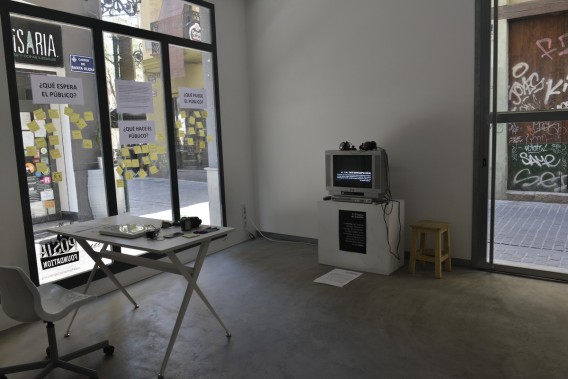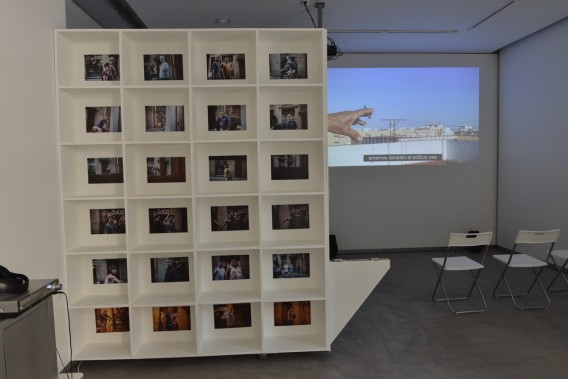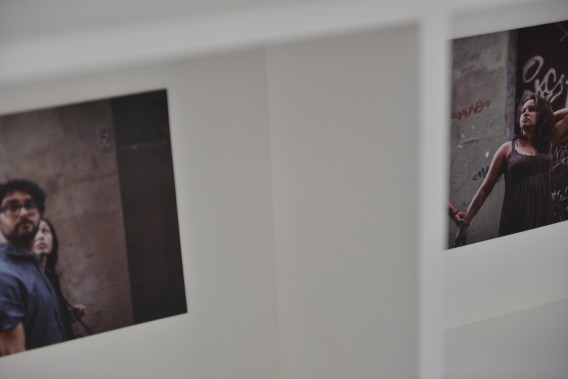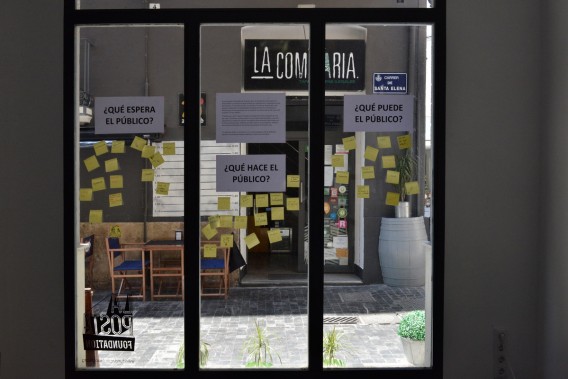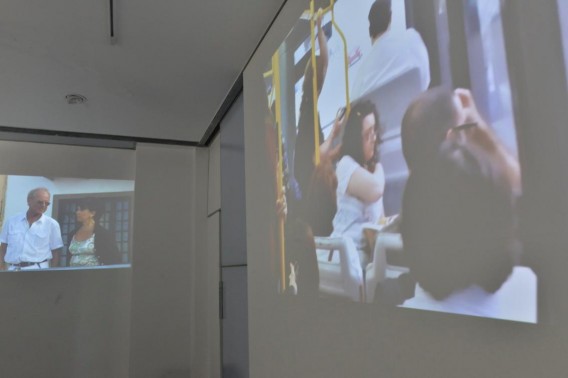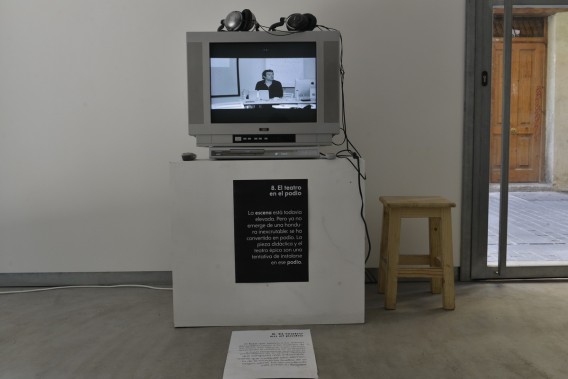1
From the third season of “Cinema to come” held in 2015, the project team developed a monitoring process with viewers and spectators who attended the screenings, lectures and workshops this year. This collaborative process has enabled the realization of a number of film pieces that have been exhibited at the La Posta Foundation, within the framework of the project “In the limits” (May-June 2015).
Thus, “In the limits (Part 2): Public to come” stated, throughout the month of June, work done by the public “Cinema to come”. Or rather by different public. The public is plural as is the public space itself, and in this exhibition has been made visible public practice variously related to contemporary cinema, plural and diverse public that have converged and found in the various proposals for “Cinema to come”.
Post, do something public, is both to give public access to certain content and make the public sphere which makes them accessible. Post is made public, even from a private initiative. The convergence project between “Cinema to come” and La Posta Foundation finds its anchor in the attention to the public as actual or potential producers, and generating innovative contexts of reception for contemporary cinematic experience. Make public today is also build places and times for public of cinema to come.
Epistemological questions of our project are: For who ?, and what for? film is done today (Villasante, 2006). Why and for whom a particular social process develops around a movie? In parallel to these issues methodological questions arise: Who? He makes movies today, and how? The process of “Public to come” is an approach to different audiences, artists or not, potential or de facto, from works and film processes performed by the viewers of the seasons of “Cinema to come”. It is also a socio-filmmaking approach to contemporary public space, a common area that is built the same way that public within it.
2
Public, it is known, they are constructed. The public is configured from several strategies: education, advertising, marketing, distribution monopolies or state that science called statistics (Ibañez, 2014). At a time of rampant privatization of the public as we live, in “Public to come” we asked if coordinated action of a variety of audiences that are organized to build their own spaces of visibility, production and circulation could not provide innovative ways of collective construction of public space.
Rather than going to cultural production instituted to capture and setting of “new audiences”, invert the terms and develop a practice in which to make public emanates from their own initiative of the public. It may happen then that the public themselves who are organizing a unique production and distribution, build new ways to get film production and institute well, those parcels of public sphere (non-state) that the cinema is still able to configure.
That is the bet of “Public to come”: from the creation of a small community linked to contemporary cinema to generate from it a greater plurality of participation in the imaginary filmic. It is an investigation and a collective practice, or rather a research from a collective practice around the new possibilities for make public. We intend to connect to all those artistic practices that “invent new collective processes manufacturing experimental communities”, as would Reinaldo Laddaga (2010), joint action working to “transform local states of things”.
We start from viewers to become producers of their own works, and thereby participate in a collective construction of community and the common spaces. In contemporary thought, the dichotomy between public and private is moving, ever more potency, to a reflection about the common. “Public to come” has tried inserted in this displacement, and it has sought to have tools that trigger the debate and to experience from the filmic practice what may be the role of public new spaces and times of the common.
To Dardot and Laval, authors of Common (2015): “the common is not “produced” but “instituted”. (…) A common is not a “thing”, even if it is on one thing, but the living link between a thing, an object or a place and activity of the group that is responsible for it, maintains and cares . Usually it can only be instituted as inappropriable“.
Given the gradual disappearance of public space, the production of subjectivity of the film and its ability to build public and communities of practice can be presented as active elements in the reappropriation of the public, the public no longer understood as state property or as an end in itself but as a means of institution of the common.
3
All exhibition “In the limits” (the second part has been “Public to come”) has been designed as a multi-screen experience (several active monitors at once and several simultaneous projections), with various modes of reception possible coexisting in the same space . This reception space is very close to everyday space of relationship with images that occurs today, the space multi-screen as hegemonic place today.
Public to come has been a common ground in this regard. But also to develop conversion processes common public (non-specialized) in film makers (and conventional cinema any way) have also been questioning the devices in contemporary cinema produced exclusion.
The logic of inequality and exclusion are very arduous obstacles to an effective institution of the common (Sousa Santos, 2011). So it is interesting (and probably decisive) questioned the film competence. Who is competent as a spectator of unconventional contemporary cinema? Who has the competence to do it? What institutions determine the distribution of competences? Who competing in this framework of questions?
Outside any competitive context, in “Public to come” filmmakers and not filmmakers, artists and non-artists have discussed and have been exposed to the same level in a dimension of equality (or rather horizontal) and reciprocity. Was so tempted practice setting a dialogic space: space of coexistence and dialogue between separate spheres in principle where possible think the distance derived from the conditions of production and reception, while activating a collective reflection on filmic exclusionary logic, and its devices (their concrete practices of production, reception and circulation).
This configuration has led a collaborative process established through open multiple dialog. In the same space-time exposure they were conducting a series of meetings of the group of “Public to come” to set up the exhibition itself and think about each of the activities to be performed. That collaborative work came first decision: to change the notion of “opening” for a proposed meeting, in which the visitor people were invited to participate in an open debate on the issues involved in the whole process.
“Public to come” was split along the month of June 2015, in two parts, given the large number of film pieces that were assembled and produced specifically. To “open” the second part of multiple projections, again changed the format of invitation to external audiences. We chose this time to have a participatory device in which, through three questions (what the public expects?, What the public does?, What can the public?) People could make their contributions through a post-it that they were accumulated in the side glass that limits the inside and outside of La Posta.
Within an institution like La Posta Foundation (one of whose definitions is “private institution with a vocation for public service”), we have tried to configure a dialogic space multiplied through collaborative processes of various participating public that gathered and placed in a space-time sharing, have been able to confused and blurred the boundary between public and private, collectively building a practical possibility of institution of the common.
The last element of these dialogic processes has been our collaboration with the Editorial Concreta. This platform of contemporary reflection on the image is like writing Nuria Enguita (2012) in an editorial to the first issue of the magazine, a publication that is “from a specific place, a strong community over the last fifteen years by the systematic disappearance of cultural infrastructure dedicated to the visual arts”.
The convergence of the initiatives of La Posta Foundation and “Cinema to come” with the Editorial Concreta in the area of the project “In the limits” is, therefore, another symptomatic practical experience of these processes of reflection and action on the images, the community and the common.
Our collaboration with the Editorial Concreta crystallized in two events. First, the organization of a “special Pedro Costa” at the Valencia Film Archive (Thursday 4 June), with the presence of the great Portuguese director and the screening of his latest film, Cavalo Dinheiro (2014). On the other hand the presentation on the 12th of the month, at the seat of La Posta Foundation, issue Concreta 05 and the book “Martinete de las calles” of Isaías Griñolo, which included the screening of “La Fiera De Sevilla”, video from Griñolo in collaboration with El Niño de Elche.
Dialogic space multiplied, we said. First, dialogue between the diversity of public converted into filmmakers, who have set up as collective collaboration and community participation all the details of their own exposure. But also dialogue, each person concerned with the works, dialogue between the works themselves and finally dialogue with the rest of the public who participated in the various proposals for meeting and participation that have been generated over exposure. Dialogue, finally, with projections and debates organized beside the Editorial Concreta and derived from Journeys 2015 “Cinema to come”.
4
For all that, the exhibition was set to limit or border between the private space (inside La Posta Foundation) and public space (the same inside become public experience).The time, during the exhibition, private space and public space became confused, generating local emergency, situated from a spacetime common, shared, everyday life, for a collective film experience.
The space of La Posta Foundation lends itself well to this transformation. It is a white cube, but it is not a gallery or a museum. What is it then? The local also has a transformable configuration design, and a rich spatial promiscuity between inside and outside (two of its sides are large windows), or between the private space (inside) and public space (outside). Whenever in “Public to come” meetings of people were generated in this space, public and private lost their boundaries and emerged briefly ephemeral institution of a potential space of the common.
In the second round of works presented in “Public to come,” for example, the space is transformed by removing a side tab containing a wide shelf of twenty boxes. This mobile shelving is then arranged facing the door-glass entrance to the local La Posta, and in each of the twenty-four boxes the photos that Mario Zamora (member of the collective “Public to come”) was made at the meeting which began to display the first round of works presented in “Public to come” were exposed.
Under the name of “Public profiles“, this photographic work showing still images of people who had remained on the threshold of the room during the initial event, passersby who had led their more or less fleeting glances into the space from one of La Posta its outer limits (the door-glass). A potential audience and ephemeral became, well, itself part of the exhibition “Public to come”. And although their images were fixed, collectively forming an assembly showed on the shelf of 24 frames was in front position on the door-glass (24 images that make up a second analog film medium).
Thus, the potential audience included in the process now directed his gaze in the opposite direction in which they were captured their initial looks (then outside to inside and this time from inside to outside of the local). That is, his gaze was now directed to the public that were to come, would come in fact stay at the same threshold between interior and exterior, and even through.
Although Angel Gonzalez as saying, “they call to come, because it never comes”, the truth is that new public came to meet in the next round of exposure (the busiest, in fact, the entire process). Among those audiences who peered into the following proposed “Public to come”, men and women who wanted to cross that threshold could also be included in the process. The assistant people could choose to participate with their contributions written to respond to the issues raised in the other threshold (the side glass) of La Posta local: What the public expects?, What the public does?, What can the public?
Events, emergencies, multiplication, processes, possible worlds. All this created, by the way, some confusion about what is really there (La Posta Foundation), and the nature of what was happening during these months there exhibition “In the limits”. Initial confusion generated some concern when trying apprehended as regulatory and conventional art codes, but is a real transformation power of such codes in this research laboratory in contemporary art is, in fact, the La Posta Foundation.
And the white cube (the place par excellence of contemporary art), when it belongs to a private institution, usually a mostly empty place, which deals almost exclusively in the protocol inauguration. During the two months of the project “In the limits“, the transformable space La Posta Foundation, however dealt repeatedly (meetings of working groups, encounters, seminars, various citations from the beginning of each of exposures), making the white cube became the place of the event; it got busy even many outsiders, in principle, art or contemporary cinema.
As Hito Steyerl (2015) he said: “Today, political films are no longer shown in factories. They are displayed in the museum or gallery: in the space of art. That is, in any type of white cube “.
What public have lived, then, in these repeated events “In the limits“ and “Public to come”? Artists, filmmakers, audiences turned into filmmakers, people making their first job with a camera and also what Nancy Fraser (2013) calls “subaltern counter-public” common people coming for the first time a white cube, I not even know what “white cube” means and, moreover, had for the first time a direct relationship with contemporary art or cinema.
Common people, anyone persons, public to come.
Miguel Ángel Baixauli and Sonia Martínez
__________________________
BIBLIOGRAPHY and references cited:
DARDOT, Pierre and LAVAL, Christian (2015): Común. Ensayo sobre la revolución en el siglo XXI, Ed. Gedisa, Barcelona. Watch Interview Pierre Dardot and Chirstian Laval realized by Marta Malo and Débora Ávila and published in Interferencias, Amador Fernandez-Savater’s blog in diario.es.
ENGUITA, Nuria (2012): Editorial Revista Concreta 00, Editorial CONCRETA, Valencia, autumn 2012.
FRASER, Nancy (2013): “La justicia mundial y la renovación de la teoría crítica”, en VVAA, Pensar desde la izquierda, Errata naturae editores, 2ª edición, Madrid.
IBÁNEZ, Jesús (2014): Por una sociología de la vida cotidiana, Siglo XXI Editores, 4ª edición, Madrid.
LADDAGA, Reinaldo (2010): Estética de la emergencia. La formación de otra cultura de las artes, Adriana Hidalgo Editora, Buenos Aires.
SOUSA SANTOS, Boaventura de (2001): El milenio huérfano. Ensayos para una nueva cultura política, Ed. Trotta, segunda edición, ILSA, Bogotá, 2005.
STEYERL, Hito (2015): “¿Es el museo una fábrica?”, en Los condenados de la pantalla, Caja Negra Editora, Buenos Aires.
VILLASANTE, Tomás R. (2006): Desbordes creativos. Estilos y estrategias para la transformación social, Los libros de la Catarata, Madrid.


